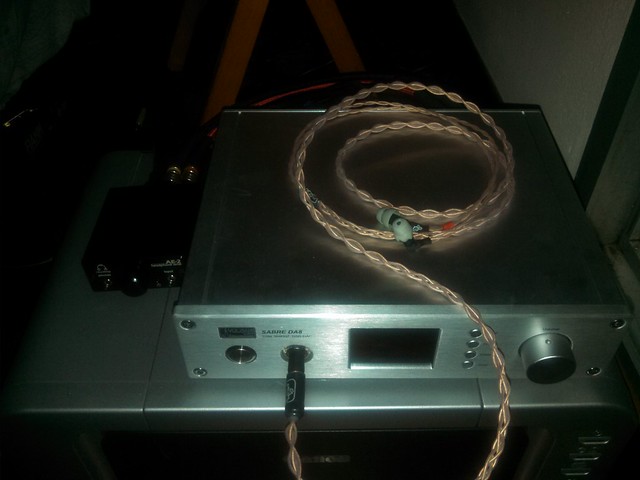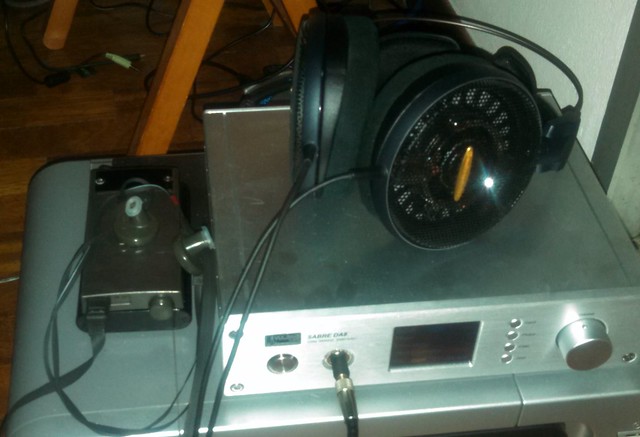Introduction
The Yulong DA8 is the new top of the line from Yulong. I have already reviewed its direct ancestor (the D18), and I in the past I had owned Yulong DAH-1 (the first DAC made by Yulong, a few years ago). When comparing the two, I had found with pleasure that they evolved the sound signature from a bright approach, towards the more musical, cohesive approach of the D18. Such D18 used the ESS Sabre dac chipset, but managed to sound warm, coherent, albeit a bit small, soundstage-wise. It also had a different signature when used in balanced (native) mode, compared to single ended (less mature sounding).
The DA8 is an all integrated solution, offering a very good USB input, as well as preamplifier and headphone amplifier functions.
In the following, I am going to dig into the sound of the new DA8.
I am listing its main specifications (others are to be found at the manufacturer’s website):
- Total Harmonic Distortion (THD) plus Noise (THD+N) is measured as less than 0.0002%
- Dynamic 133dB and Idle noise as low as 1.5uV
- ESS Technology SABRE32 Reference DAC / Digital Filter (ES9018S) working in 32-bit Hyperstream™ via a patented Time Domain Jitter Eliminator
- USB chip support PCM 16-32 bit, 44.1Khz 48Khz 88.2Khz 96Khz 176.4Khz 192Khz 352.8Khz 384Khz DSD64,DSD128 – On Windows DSD256,DSD512
- KS/Wasapi/WDM/ASIO Drivers for MS OS XP to Win8 32-64bit
- 5 x AD797 for voltage regulation and filtering, 2 x OPA1632 for buffer stage and preamp output
- Diamond buffer circuit for headphone output

Sound of the DAC
I have been using the DA8 with / without the iFi Power usb conditioner, and have been rolling several usb cables, including the one which came with the Antelope Zodiac, as well as that coming with Mytek 192DSD.
I have been using the Audio-Technica AD2000 headphones, as well as Stax SR-001 / 003 with the portable and SRM-727A amplifiers.
DAC’s to which I have compared it directly are: Metrum Octave Mk2 DAC, Museatex Idat44-Mobile, Mytek 192 DAC.
I have been using it with the Foobar2000 (MP3) and JPlay (FLAC). The DA8 is compatible with the Kernel Streaming in Windows 8, hence it can be used with JPlay’s ULTRAStream playback engine (the best one).
The DA8 is a bit different from other Sabre based DAC’s I have listened to. It has some tubey traits, which I haven’t recognized in any of its sibling. It has very strong dynamics, very powerful, vibrating bass and and thick midrange.
The bass offers a strong sense of ambience and adds up to the soundstage, as well as to the sense of rhytm.
The soundstage is wider than the D18 (Yulong’s previous DAC design). Compared to the D18, whose single ended output sounded less involving than the (native) balanced output, the DA8 has very high quality single ended, which I found of the same quality as balanced outputs. This could have been expected, because the DA8 has been built also to be a premp and headphone amp, hence more care has been given to all the analogue circuitry.
I have heard many “neutral” DAC’s, which can maybe sound very clean, warmish, smooth, but don’t push the music enough.
The Yulong is a step closer towards the Museatex style: the midrange with the Yulong is super involving, forward, it goes after the music, like it happens with the Idat44 DAC or the AMR (and, to a smaller degree, with the Eximus DP1 and the Metrum Octave Mk2). All the other digital sources I have been trying, present the midrange in a more linear way, which can offer better clarity (in certain cases), but is often much more polite in conveying the musical energy.
The upper bass has something euphonic, in how the resonance decays. This makes the bass and midrange work very well together.
It feels like the Yulong DA8 has been designed by a team who had a lot of fun with it and wanted to make something “kickass”.
There is a trade off compared to other machines (like the Mytek 192DSD or Audiogd 9.2) which present the stage in more polished manner and can make the details easier to spot, but don’t make the listener so actively involved and triggered like the DA8 does.
With the wrong equipment, like the AD2000, it can be too much: the combo is shrill and the traits of the AD2000 get excessively stressed. With less aggressive headphones, being Stax, Sennheiser HD600 and several others, the DA8 is a hit because it’s an inspired active player in the audio chain.
USB Receiver Quality
The USB chip, named Combo384, has been custom developed with the Italian Amanero. The input quality is very good, mainly because the Sabre chipset is closer to a CPU than just a DAC chip, and it’s pretty insensitive to transport when well implemented. This means, that something like an Audiophilleo (or another good interface under 1000 $) isn’t needed to exploit the DA8 potential.
With the cables I have been trying, I didn’t notice a very noticeable difference like I had with other sources (like the AMR DP777 I have listened at a friend’s place, or the Metrum), although I didn’t have the Forza Audioworks twin cable to add up to the comparison.
Using the iFi iUSBPower does make the top end more fluid, and gives a better sense of ambience.

Amplification
The headphone amplifier is clean. Using it with my pair of Etymotic ER4 (with custom impedance of 35 Ohm), it doesn’t present any white noise.
Apart from using the Etymotic ER4, I have mainly tested the amp section with Audio Technica AD2000. With both, I detected it to sound a bit drier than the Headamp AE-2.
The DA8 headphone amplifier is more detail oriented than the AE2 (which sounds very warm in conjunction with the AD2000), while not offering the same level of separation as the Bryston BHA-1, which I have tried with the same AD2000.
The headamp is noticeably better than the Mytek 192DSD one, which I consider the weak part of Mytek’s offering, given its digital, slightly unnatural sound.
I believe the amplifier is more oriented for higher impedance headphones, mainly because of its output power and tendency to a slight U-shape with both my low impedance/high efficiency headphones.
The preamplifier section is clean and more linear than how the headphone out sounds with the AD2000, but benefits about the full and forward sounding tonality of the DAC itself. It melts well with the SRM-727A used in power amp mode (bypassing its own volume control). Such Stax amplifier is “solid state” done right, not sounding any harhs. I would say, given the tonality of the DA8 dac/pre as a whole, that it can work pretty well with well made solid state power amps (like also Meitner MTR-101 amps, Naim power amps, hybrids) as well as clear sounding tube amps, while staying away from the extremes (brighter solid state power amps or overly warm tube amps) with this DAC/preamp, given it already has a significant (and very effective) personality.
The Pre-amplifier in balanced mode (XLR output) can be used as fully balanced headphone amplifier. Unfortunately, I don’t have a balanced headphone to use in this test, but I’d most likely go with either a balanced Sennheiser HD600 or HD650, which among the headphones to improve the most in balanced operation, and have a frequency response to melt very well with the DA8.
Conclusion
The DA8 is one of those few DAC’s which I consider “worth of its price”. This is something I almost never say, but it sounds better than most (if not all) the units in its price range.
It is very capable of making music, sounding toe-tapping, has super strong dynamics. It can ask for some trade-offs, namely, not using super aggressive headphones (like Audio-Technica AD2000 or Grado), but they are minor. In exchange, it offers a very involving, addictive sound, good tone with high degree of detail retrieval.
The headphone amplifier and preamplifier functions are well implemented. The amplifier isn’t for all kinds of headphones, but it is very listenable. I have heard several other integrated headphone amps (within a dac/amp combo) that sound much inferior to this one.
Probably, I would want something better than the integrated headphone amp to enjoy the DA8 dac fully, and I would also want to use a high end headphone, and pay separately for a high end amplifier for it. In any case, even if I weren’t using the amplifier section, I would consider the purchase well worth the money, since the dac alone, along with its usb input, high quality single-ended and balanced output, DSD compatibility and connectivity deliver more than I would have expected in the price range.


